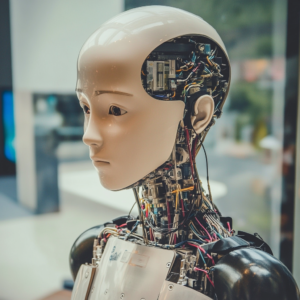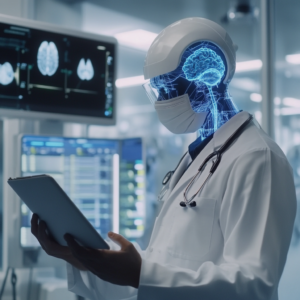AI and the Future of Work: Will Robots Take Over Jobs?
Artificial Intelligence (AI) is transforming industries worldwide, driving innovation, and altering the landscape of work as we know it. As automation and AI-powered systems continue to advance, many are left wondering: Will robots take over jobs in the future? While there’s no simple answer to this question, the impact of AI on the future of work is a topic that requires a deeper look at both the potential risks and opportunities.
The Rise of Automation: What’s Happening Now?
AI technologies, especially in areas such as machine learning, natural language processing, and robotics, are automating tasks that were once solely done by humans. From self-driving cars to AI-driven customer service, many routine and repetitive tasks are being taken over by machines. Industries such as manufacturing, retail, and even healthcare are already seeing a shift toward automation.
But it’s important to note that AI is not just replacing jobs—it’s also creating new opportunities. According to a report from the World Economic Forum, while 85 million jobs might be displaced by automation by 2025, around 97 million new roles could emerge as a result of AI advancements. These roles will require new skills, often blending human creativity with AI-powered efficiency.
Jobs Most Vulnerable to Automation
Some jobs are more likely to be automated than others. Jobs that involve routine, predictable tasks, such as data entry clerks, assembly line workers, or even fast food service employees, are considered high-risk for automation. The use of robots in warehouses or autonomous drones for delivery are clear examples of how AI is disrupting traditional roles.
However, roles that require complex decision-making, emotional intelligence, and creativity—such as managers, doctors, teachers, and artists—are less likely to be fully replaced by AI. These roles involve skills that machines have not yet mastered.
Opportunities in the AI-Driven Job Market
While it’s true that some jobs are being replaced, AI is also driving the creation of new, innovative roles. These jobs often require a unique blend of technical and interpersonal skills, including:
- AI Specialists: As companies adopt AI technologies, they need skilled professionals to develop, train, and maintain AI systems.
- Data Analysts: AI generates enormous amounts of data, creating a demand for people who can interpret this data and help organizations make informed decisions.
- AI Ethicists: As AI becomes more integrated into society, ethical concerns arise. Roles focused on the ethical implications of AI will grow in importance.
- Human-Machine Teaming Managers: In roles where humans work alongside AI systems, new management skills are required to optimize this partnership.
These emerging jobs demonstrate that the future of work is not solely about automation replacing humans, but about creating new ways for humans and AI to collaborate effectively.
The Skills Gap: Preparing for the Future
As AI continues to evolve, it’s crucial for the workforce to adapt. Upskilling and reskilling are becoming more important as certain tasks become automated. In this AI-driven economy, skills such as complex problem-solving, creativity, emotional intelligence, and adaptability are gaining prominence.
Educational institutions and organizations are beginning to recognize the importance of preparing the future workforce for AI’s impact. Courses in AI, data science, and technology are becoming more prevalent, ensuring that individuals have the skills necessary to thrive in an automated world.
Can AI Really Replace Human Creativity and Empathy?
While AI can outperform humans in tasks that require precision, speed, and efficiency, there are areas where machines fall short—particularly in creativity and emotional intelligence. Jobs that require complex interpersonal relationships, leadership, and creative thinking are areas where humans are still far superior.
For example, while an AI algorithm can assist in diagnosing medical conditions, it cannot provide the emotional support and empathy that patients expect from their healthcare providers. Similarly, while AI can generate content or artwork, it lacks the nuance and emotional depth that human creativity brings to the table.
The Future: Collaboration, Not Competition
The future of work is not necessarily a competition between humans and machines, but rather an opportunity for collaboration. AI has the potential to enhance productivity and free humans from mundane, repetitive tasks, allowing us to focus on higher-value activities. For instance, AI can handle data analysis, leaving more time for human-driven decision-making and strategic thinking.
Moreover, AI could democratize access to skills, providing individuals with AI-powered tools to excel in tasks that previously required specialized training. For example, AI-powered coding tools can enable more people to learn programming, and AI-driven design software can help non-designers create professional-quality visuals.
Conclusion: Adapting to the Future of Work
The rise of AI and automation is reshaping the world of work, but it doesn’t mean that robots will take over all jobs. While some roles may be automated, new opportunities are emerging, and the future workforce will need to adapt by acquiring new skills. The key to thriving in the AI-driven world lies in embracing lifelong learning, developing human-centric skills, and fostering collaboration between humans and machines.
The future of work is not about AI replacing humans, but about humans and AI working together to unlock new possibilities.



Bionic prosthetics powered by Artificial Intelligence represent a remarkable advancement in medical technology, significantly improving the quality of life for individuals with limb loss or impairment. These AI-driven prosthetics combine robotics, AI algorithms, and advanced sensor technologies to create highly functional, life-like artificial limbs that offer better movement and control compared to traditional prosthetics.
Here’s how AI plays a crucial role in bionic prosthetics:
-
Enhanced Control and Movement: AI in bionic prosthetics allows for more natural movement by processing real-time data from sensors embedded in the prosthetic. These sensors detect muscle signals or nerve impulses from the user’s body, and AI algorithms translate these signals into precise movements. This enables users to perform complex actions such as gripping, walking, or even running with greater ease and accuracy.
-
Learning and Adaptation: AI-powered bionic prosthetics have the ability to learn and adapt to the user’s specific movements and patterns over time. Machine learning algorithms analyze repetitive actions and optimize the prosthetic’s response, creating a personalized experience. This adaptability helps improve user comfort and functionality as the device becomes more intuitive to their needs.
-
Sensory Feedback: Modern AI-driven prosthetics are also incorporating sensory feedback mechanisms. AI allows these prosthetics to simulate sensations such as touch, pressure, or temperature by sending signals back to the user’s nervous system. This creates a more immersive experience, giving users a sense of control and awareness similar to natural limbs.
-
Predictive Motion Control: With the help of predictive AI models, bionic prosthetics can anticipate a user’s intended actions. For example, when a user begins to reach for an object, AI algorithms can predict the type of grip or force needed and adjust the prosthetic’s motion accordingly. This predictive ability enhances the precision and fluidity of movements.
-
User-Friendly Customization: AI also simplifies the customization of bionic prosthetics. Through the use of AI software, users and technicians can easily adjust settings to match the user’s specific requirements. This includes configuring movement speeds, grip strengths, and response sensitivity, all of which can be fine-tuned over time.
-
Real-World Applications: AI-powered bionic prosthetics are being used in a wide range of scenarios, from everyday tasks like walking and holding objects to more specialized activities, such as sports. In some cases, these prosthetics have allowed athletes to return to competition after limb loss, demonstrating the strength and versatility of AI-driven solutions.
Overall, AI-powered bionic prosthetics represent a significant leap forward in assistive technology, offering users a greater degree of independence, comfort, and functionality. With continuous advancements in AI and robotics, the future of prosthetic technology looks even more promising.
Top 5 AI-Powered Tools for Businesses
In today’s competitive landscape, businesses are increasingly turning to Artificial Intelligence (AI) to streamline operations, enhance productivity, and gain a competitive edge. AI-powered tools have become essential for improving decision-making, automating repetitive tasks, and delivering personalized customer experiences. Whether you’re a small business or a large enterprise, AI tools can significantly enhance efficiency and profitability.
In this post, we’ll explore the Top 5 AI-powered tools for businesses and how they can transform the way you work.
1. Jasper AI (Formerly Jarvis) – AI for Content Creation
What it is: Jasper AI is an AI-powered writing assistant designed to help businesses create high-quality content faster. Whether you’re crafting blog posts, social media content, emails, or marketing copy, Jasper AI can generate creative, engaging, and SEO-friendly content in minutes.
Key Features:
-
Generates content for blogs, product descriptions, and advertisements.
-
Offers SEO optimization suggestions to improve search engine rankings.
-
Provides templates for different content types, from emails to social media posts.
-
Supports over 25 languages, making it a great tool for businesses with global audiences.
How it helps businesses: Jasper AI saves time and resources by automating the content creation process, allowing businesses to focus on strategy and growth. It’s perfect for marketing teams that need a steady flow of content but lack the manpower or time to generate it manually.
2. HubSpot – AI-Powered Customer Relationship Management (CRM)
What it is: HubSpot is a comprehensive AI-powered CRM platform that helps businesses manage customer relationships, automate marketing tasks, and provide personalized customer experiences. Its AI features enhance lead scoring, email marketing, and customer service automation.
Key Features:
-
AI-driven lead scoring to identify high-potential prospects.
-
Automated email marketing campaigns tailored to individual customer behavior.
-
AI chatbots for 24/7 customer support and lead generation.
-
Predictive analytics to forecast sales trends and performance.
How it helps businesses: HubSpot’s AI features help businesses automate tedious tasks like email follow-ups, lead qualification, and customer service inquiries, freeing up teams to focus on building stronger customer relationships and growing sales.
3. Grammarly – AI Writing Assistant for Professionals
What it is: Grammarly is an AI-powered writing tool that ensures clear, concise, and error-free communication. It helps businesses maintain professional communication across all channels, whether it’s emails, reports, or customer-facing content.
Key Features:
-
Real-time grammar and spelling corrections.
-
Style suggestions to enhance clarity and tone.
-
Plagiarism checker to ensure original content.
-
Tone detector to match content style with the intended audience.
How it helps businesses: Effective communication is critical in business, and Grammarly ensures that your emails, proposals, and other written materials are polished and professional. It saves time on editing while improving the overall quality of your written communication.
4. Zoho Analytics – AI-Powered Data Analytics Tool
What it is: Zoho Analytics is an AI-powered business intelligence and analytics platform that helps businesses visualize and analyze data from various sources. With AI-enhanced reporting and predictive insights, businesses can make data-driven decisions.
Key Features:
-
AI-powered predictive analytics and forecasting.
-
Automated data blending and reporting.
-
Drag-and-drop interface for easy data visualization.
-
Integration with multiple platforms (CRM, marketing, finance tools).
How it helps businesses: Zoho Analytics enables companies to harness the power of their data without needing a dedicated data science team. By turning raw data into actionable insights, businesses can optimize operations, forecast trends, and uncover growth opportunities.
5. Tidio – AI-Powered Chatbots for Customer Support
What it is: Tidio is an AI-powered live chat and chatbot platform that enhances customer service by automating responses to customer inquiries. Its AI chatbots handle common customer queries, allowing businesses to provide 24/7 support without needing a full-time team.
Key Features:
-
AI chatbots that can answer frequently asked questions.
-
Real-time live chat for personalized customer service.
-
Integration with eCommerce platforms like Shopify and WooCommerce.
-
Automated lead generation and follow-up processes.
How it helps businesses: Tidio reduces response times and improves customer satisfaction by handling queries instantly. It’s especially useful for small businesses that want to offer consistent customer support without hiring additional staff. AI chatbots can also assist with upselling and lead nurturing.
Conclusion: Enhancing Business Efficiency with AI
AI-powered tools are no longer a luxury; they’re a necessity for businesses that want to stay ahead in a digital-first world. From content creation to data analytics and customer support, AI offers a range of solutions that can significantly enhance productivity, streamline operations, and improve customer experience. By integrating AI tools like Jasper, HubSpot, Grammarly, Zoho Analytics, and Tidio into your workflow, your business can save time, reduce costs, and stay competitive.
As AI continues to evolve, the number of tools available will only increase, giving businesses more opportunities to automate tasks, optimize performance, and focus on growth.
This post outlines some of the best AI-powered tools available, showcasing how they can be applied to various business operations to drive efficiency and success.
How Artificial Intelligence is Revolutionizing Healthcare
Artificial Intelligence (AI) is at the forefront of transforming industries, and healthcare is one of the most impacted sectors. From diagnosing diseases to developing personalized treatments, AI is revolutionizing the way healthcare is delivered, making it more efficient, accurate, and accessible. This post explores the various ways AI is reshaping healthcare and what the future holds for AI-driven medical innovation.
1. AI for Early Disease Detection and Diagnosis
One of the most promising applications of AI in healthcare is its ability to detect diseases early and improve diagnosis accuracy. By analyzing vast amounts of medical data, including patient records, genetic information, and imaging scans, AI algorithms can detect patterns that might go unnoticed by human doctors.
For example, AI-powered tools like IBM’s Watson Health and Google’s DeepMind are being used to assist in diagnosing diseases such as cancer, heart disease, and neurological disorders. In radiology, AI algorithms can analyze medical images (such as X-rays, MRIs, and CT scans) with remarkable precision, often detecting abnormalities earlier than traditional methods.
How it helps: Early detection of diseases significantly improves the chances of successful treatment and recovery. AI-powered diagnostic tools enable faster and more accurate diagnoses, helping doctors provide timely and targeted interventions.
2. Personalized Medicine and Treatment Plans
The concept of personalized medicine—tailoring treatment plans to individual patients based on their genetic makeup and medical history—has gained momentum with the help of AI. Machine learning models can analyze a patient’s genetic data, lifestyle, and previous treatments to recommend the most effective therapies.
For example, AI-driven platforms like Tempus and Flatiron Health use advanced data analytics to provide personalized treatment recommendations for cancer patients. These systems analyze clinical and molecular data to suggest the most appropriate treatment options based on previous outcomes.
How it helps: Personalized treatment plans ensure that patients receive the best possible care tailored to their unique needs, improving outcomes and reducing the risk of adverse reactions to treatments.
3. AI in Drug Discovery and Development
Developing new drugs is a time-consuming and expensive process, often taking years and costing billions of dollars. AI is streamlining this process by identifying potential drug candidates and predicting how they will interact with the human body.
For instance, companies like Atomwise and Insilico Medicine use AI to analyze millions of chemical compounds and predict their effectiveness in treating diseases. AI models can simulate how different compounds will interact with biological systems, drastically speeding up the drug discovery process.
How it helps: AI-driven drug discovery reduces the time and cost associated with bringing new drugs to market, making treatments more accessible and affordable. Additionally, AI can help identify existing drugs that could be repurposed for other conditions, further expanding treatment options.
4. Enhancing Medical Imaging and Radiology
Medical imaging is another area where AI is making a significant impact. AI algorithms can analyze medical images to detect diseases, track disease progression, and even predict treatment outcomes. These tools are particularly useful in radiology, where doctors often need to review large volumes of scans to make a diagnosis.
AI-powered imaging tools, like Zebra Medical Vision and Aidoc, are being used to assist radiologists in identifying tumors, fractures, and other abnormalities in medical scans. These systems can work alongside human radiologists, providing a second opinion and reducing the risk of misdiagnosis.
How it helps: AI improves the speed and accuracy of medical imaging analysis, helping radiologists make better-informed decisions and enabling earlier treatment for patients.
5. AI-Powered Virtual Health Assistants
AI-powered virtual health assistants are becoming increasingly popular in managing patient care and improving healthcare accessibility. These assistants, often in the form of chatbots or voice-activated systems, provide patients with personalized health advice, appointment scheduling, medication reminders, and more.
For example, apps like Babylon Health and Buoy Health use AI to assess symptoms, suggest possible diagnoses, and offer next steps for treatment. These systems can answer common health questions and help patients determine whether they need to see a doctor, reducing unnecessary visits to healthcare facilities.
How it helps: AI-driven virtual health assistants make healthcare more accessible, particularly in areas where medical professionals are scarce. They also empower patients to take control of their health, providing guidance on managing chronic conditions and ensuring that they stay on track with treatment plans.
6. AI in Surgery: The Rise of Robotic-Assisted Procedures
AI is playing a pivotal role in enhancing surgical precision and outcomes. Robotic-assisted surgeries, guided by AI, are enabling surgeons to perform minimally invasive procedures with greater accuracy and control. Systems like the da Vinci Surgical System use AI to assist surgeons in performing complex operations with enhanced precision, reduced blood loss, and faster recovery times for patients.
Additionally, AI-powered systems are being used to develop surgical training simulations, allowing surgeons to practice procedures in a virtual environment before performing them on patients.
How it helps: AI enhances surgical outcomes by reducing human error and enabling more precise, minimally invasive procedures. This leads to faster patient recovery times, fewer complications, and improved overall care.
7. Predictive Analytics for Better Healthcare Management
AI is transforming how hospitals and healthcare systems manage resources and deliver care. Through predictive analytics, AI can forecast patient needs, optimize hospital workflows, and reduce waiting times. For example, AI can predict patient admission rates, enabling hospitals to allocate resources more efficiently and avoid overcrowding.
Predictive models can also analyze patient data to identify those at risk of developing chronic diseases, allowing healthcare providers to intervene early and implement preventive measures.
How it helps: Predictive analytics enables healthcare providers to optimize patient care, reduce costs, and improve operational efficiency, leading to better patient outcomes and a more sustainable healthcare system.
Challenges and Ethical Considerations
While AI offers immense potential in healthcare, it’s important to address the challenges and ethical considerations associated with its adoption. Privacy concerns, the potential for algorithmic bias, and the need for human oversight are critical issues that must be carefully managed to ensure the safe and equitable use of AI in healthcare.
Conclusion: The Future of AI in Healthcare
Artificial Intelligence is revolutionizing healthcare by improving diagnosis accuracy, personalizing treatment plans, accelerating drug discovery, and enhancing patient care. As AI technology continues to evolve, its impact on healthcare will only grow, leading to more efficient, accessible, and effective medical care.
However, as with any technological advancement, it’s important to balance the benefits with ethical considerations and ensure that AI is used responsibly to enhance—not replace—the human touch that remains essential in healthcare.
The future of healthcare is undoubtedly intertwined with AI, and the innovations we’re seeing today are just the beginning of a much larger transformation in how we approach medicine and patient care.
How AI is Changing the Face of Social Media
Social media has become an integral part of modern life, connecting billions of people across the globe and influencing everything from culture to commerce. But as the sheer volume of content on platforms like Facebook, Instagram, Twitter, and TikTok continues to grow, Artificial Intelligence (AI) is playing an increasingly pivotal role in shaping how social media operates. From content recommendations to user engagement and even advertising strategies, AI is transforming the social media experience for users and businesses alike.
In this post, we’ll explore the various ways AI is changing the face of social media and what it means for the future of these platforms.
1. Personalized Content Recommendations
Ever wondered how platforms like Instagram and TikTok seem to “know” what content you’ll enjoy? That’s AI in action. AI algorithms analyze vast amounts of data about user behavior—what you like, share, and engage with—to tailor your content feed. This data includes everything from the time you spend on a particular post to the accounts you follow and even the types of comments you leave.
By leveraging machine learning and natural language processing, AI can predict which posts, videos, and advertisements are most likely to keep users engaged. These personalized recommendations not only improve the user experience but also keep users on the platform longer, boosting engagement rates.
How it helps: AI-driven content personalization makes social media more engaging by delivering tailored experiences for each user, ensuring that they see relevant content that aligns with their interests.
2. Enhancing Social Media Advertising
AI has revolutionized social media advertising by enabling more precise targeting and personalization. Advertisers now rely on AI tools to analyze user demographics, interests, online behavior, and even psychographics to create highly targeted ad campaigns. Instead of casting a wide net, businesses can deliver ads directly to users who are most likely to convert.
For example, Facebook Ads Manager uses AI to identify and reach custom audiences, optimizing ad spend by focusing on high-value customers. Additionally, AI-powered tools like Google’s Smart Bidding automatically adjust bids in real-time, based on how likely a user is to take a desired action, such as making a purchase or clicking on a link.
How it helps: AI optimizes social media advertising by delivering personalized ads to the right audience, reducing costs for businesses and increasing the likelihood of conversions for advertisers.
3. AI-Powered Chatbots for Customer Service
AI-powered chatbots are becoming more prevalent on social media platforms, particularly for businesses looking to improve customer service. These chatbots can respond to customer inquiries 24/7, answering frequently asked questions, assisting with purchases, and providing support without the need for human intervention.
For example, Facebook Messenger chatbots are used by businesses to manage customer interactions, process orders, and even send personalized product recommendations. The use of natural language processing allows these bots to understand and respond to customer queries in a conversational manner, enhancing the user experience.
How it helps: AI chatbots streamline customer service on social media, offering immediate responses and solutions to common problems, which boosts customer satisfaction and reduces the workload for support teams.
4. Social Media Monitoring and Sentiment Analysis
AI is also playing a key role in social media monitoring, allowing businesses to track and analyze conversations about their brand in real time. AI-powered sentiment analysis tools scan social media platforms to gauge how users feel about a particular topic, product, or brand by analyzing the language used in posts, comments, and reviews.
These tools help businesses understand public sentiment, identify potential crises before they escalate, and adjust their strategies accordingly. Platforms like Brandwatch and Sprout Social use AI to monitor social media conversations, providing actionable insights into customer perceptions and emerging trends.
How it helps: AI-driven social media monitoring enables businesses to stay on top of public sentiment, allowing them to make data-driven decisions and respond to trends or issues in real time.
5. AI-Generated Content
Content creation on social media can be time-consuming, but AI is helping to automate parts of this process. AI-powered tools can now generate social media posts, captions, and even images or videos, making it easier for businesses to maintain a consistent online presence.
Tools like Copy.ai and Lumen5 use machine learning to create engaging social media copy and visuals based on user input, saving time for content creators. Similarly, AI algorithms can help suggest trending topics or hashtags, giving businesses a competitive edge when creating content that resonates with their audience.
How it helps: AI-generated content tools reduce the time and effort required to produce high-quality social media posts, enabling businesses to stay active and relevant without the need for extensive resources.
6. Filtering Harmful Content and Moderation
As social media platforms grow, so does the challenge of moderating the vast amount of content shared every second. AI is being used to detect and remove harmful or inappropriate content, such as hate speech, graphic violence, or misinformation. Platforms like Facebook, Twitter, and YouTube use AI-powered moderation tools to scan posts, comments, and videos in real time.
AI algorithms can identify patterns associated with harmful behavior, flagging content that violates community guidelines and even removing it automatically. While AI moderation is not perfect and still relies on human oversight, it has become an essential tool in ensuring safer online spaces for users.
How it helps: AI-powered moderation helps maintain the integrity of social media platforms by filtering out harmful content and promoting a safer environment for users.
7. Influencer Marketing and AI Matching
Influencer marketing has become one of the most popular strategies for brands on social media. AI is changing how brands connect with influencers by providing tools that analyze influencer performance, audience demographics, and engagement rates. AI-powered platforms like AspireIQ and Influencity match businesses with influencers whose audience aligns with their target market, ensuring a higher return on investment for influencer campaigns.
These tools can also help identify emerging influencers, analyze engagement trends, and predict the success of campaigns, making it easier for brands to optimize their influencer partnerships.
How it helps: AI enhances influencer marketing by helping brands find the right influencers, improving campaign effectiveness, and making data-driven decisions about partnerships.
The Future of AI in Social Media
AI’s role in social media is only expected to grow as platforms become more sophisticated and user expectations evolve. From predictive analytics to immersive experiences powered by augmented reality (AR) and virtual reality (VR), AI will continue to push the boundaries of what’s possible on social platforms.
For users, AI will make social media more personalized, intuitive, and engaging. For businesses, it will offer even more opportunities to reach customers, automate processes, and create content that resonates with their audience.
Conclusion
Artificial Intelligence is changing the face of social media by enhancing content personalization, improving customer engagement, and revolutionizing how businesses approach advertising and marketing. As AI continues to evolve, its influence on social media platforms will only increase, creating new possibilities for both users and businesses.
Whether it’s through smarter ads, AI-driven chatbots, or content recommendation engines, AI is reshaping the social media landscape and setting the stage for an even more connected and engaging digital future.







